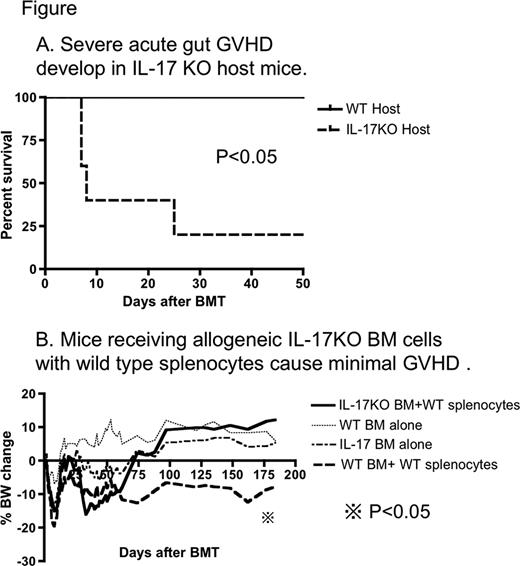Abstract
Abstract 3741
Th17 is a newly identified T cell lineage that secretes the proinflammatory cytokine IL-17. Th17 cells have been shown to play a crucial role in mediating autoimmune diseases such as experimental autoimmune encephalomyelitis (EAE), arthritis, and colitis. Anti-IL-17 therapy for some autoimmune diseases in clinical settings has been started and promising results have been reported. However the role of IL-17 on developing acute and chronic GVHD in hematopoietic stem cell transplantation (HSCT) is not yet fully understood. Interaction between IL-17 and IL-17 receptor is complicated because IL-17 is produced in various kinds of immune cells other than CD4+ T-cells, and IL-17 receptors express on not only immune cells but also various epithelial cells, including lung and intestine, both of which are target organs of GVHD. To explore the role of host derived or donor derived IL-17 separately in acute GVHD, lethally irradiated wild type (WT) or IL-17 knockout (KO) Balb/c (H-2d) were given WT or IL-17 KO C57BL/6 (H-2b) bone marrow (BM) cells with WT splenocytes to induce acute GVHD. Infused cell number of WT splenocytes in this study induced acute GVHD, but not lethal in IL-17 WT host mice. In contrast, IL-17 KO host mice receiving WT BM plus WT splenocytes developed severe acute gut GVHD and finally half of them died (p<0.05). To exclude the possibility that alloreactivity of host IL-17 KO derived dentritic cells (DCs) could be much more than that of WT DCs, mixed leukocyte reaction (MLR) was performed using stimulators from WT or IL-17 KO DCs and responders from WT CD4+ T-cells. No significant differences were observed between WT DCs and IL-17 KO DCs in thymidine uptake and percentage of responder cells producing IFN-g or TNF-a. Taken together, host-derived IL-17 has a protective effect against acute GVHD. Moreover similar results were observed when IL-17 KO Balb/c mice were given BM cells from another strain B10.D2 plus splenocytes shown in the figure below (p<0.05). Next, we compared the development of chronic GVHD between the lethally irradiated WT Balb/c mice given IL-17 KO C57BL/6 BM cells or WT BM cells with low dose WT splenocytes to induce sublethal acute GVHD and chronic GVHD subsequently. After day 60 the mice receiving WT BM cells plus WT splenocytes experienced weight loss accompanied by skin histological changes (p<0.05, shown in the figure below), while mice receiving IL-17 KO BM plus WT splenocytes showed minimal signs of GVHD as well as mice receiving IL-17 KO BM or WT BM alone. Increased number of donor-BM derived IL-17 producing cells was observed in the mice showing chronic GVHD compared to BM control (p<0.05). Moreover, a significant increase of T-cell proliferation was observed by adding rIL-17 into MLR culture (p<0.05). These results suggest that donor BM derived IL-17 producing cells involved in the pathogenesis of chronic GVHD by exacerbating the alloimmune response in part. In conclusion IL-17, especially from host-derived, has a protective effect against acute GVHD. On the contrary, donor BM derived IL-17 exacerbates chronic GVHD. Neutralizing IL-17 would be a potent strategy only for preventing chronic GVHD, not for acute GVHD.
No relevant conflicts of interest to declare.
Author notes
Asterisk with author names denotes non-ASH members.


